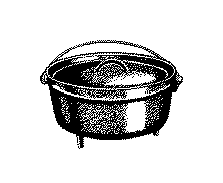
TRAVELLING IN A COVERED WAGON
(Prairie Schooner, Conestoga Wagon)

TRAVELLING IN A COVERED WAGON
(Prairie Schooner, Conestoga Wagon)
THE PRAIRIE SCHOONERThe Prairie Schooner was one way that pioneers travelled. The Prairie Schooner was a large wagon with a framework over it. The frame was covered with white canvas. The wagons measured over a meter in width (four feet) and three and a half meters long ( twelve feet). This wagon was a family's home for months. In the wagon was everything that family would need - bedding, clothing, pots, pans and dishes, food and water, butter churn, washtub and pails. The pioneers also brought hunting gear (guns and ammunition) and some furniture. Tools (crow-bar, axes, shovels, hammer) and other supplies were hung on the sides of the wagon.
 Clothing was packed in chests. Dishes, linens, books, pictures and other special items were carefully packed in a trunk. The dishes used for the trip were made of tin.
 Meals were prepared outdoors. Food that was packed for the long journey included bacon, coffee, flour, sugar, salt, corn meal, bags of rice, beans, and dried fruit. Water was carried in barrels.
Furniture might include a table, chairs and spinning wheel. Furniture that would not fit in the wagon would have to be bought or made later. Cattle and chickens were also taken on the journey. The cattle were tied to the wagon and walked along behind it. Chickens were kept in a coop. CONESTOGA WAGONThis type of wagon was first used in the eastern United States for hauling freight (cargo). The wagons were large and heavy with a canvas cover to protect the supplies. Because of the size and weight these wagons were pulled by teams of horses or oxen (4,6,8 or more). The wagons carried supplies to forts, mining camps and communities. These wagons were widely used before the railroad was built.Pioneers preferred to use the prairie schooner. It was smaller in size and easier to handle. ON THE TRAILThere were no roads, just rough trails. People travelled together in wagon trains. This was safer and they could also help each other when necessary. The wagons broke down and needed to be repaired. Tools and supplies for fixing the wagons were kept in a box attached to the outside of the wagon. When the wagon train camped for the evening they formed a circle with the wagons.
Sometimes guides were hired to lead the wagon trains. A guide would know the
shortest and safest route to take.
2004 updated 2011
|